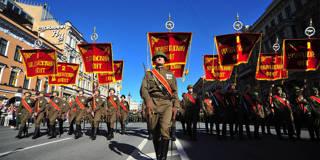If Russia’s military spending continues at its current pace, the country will deplete its reserve fund before the end of the year. If Russia could not afford a 4%-of-GDP defense budget in good times, it cannot possibly manage it now, when the country confronts rock-bottom oil prices, Western sanctions, and economic recession.
PARIS – On May 9, Russia held its largest military parade since the Soviet era. In the tradition of that era, Red Square was filled with the army’s latest equipment, including the new T-14 “Armata” tank. And, also in the tradition of that era, ordinary people were quick to joke when the tank stalled during the parade rehearsal: “The Armata truly has unprecedented destructive power; a battalion can destroy the entire Russian budget!”

PARIS – On May 9, Russia held its largest military parade since the Soviet era. In the tradition of that era, Red Square was filled with the army’s latest equipment, including the new T-14 “Armata” tank. And, also in the tradition of that era, ordinary people were quick to joke when the tank stalled during the parade rehearsal: “The Armata truly has unprecedented destructive power; a battalion can destroy the entire Russian budget!”